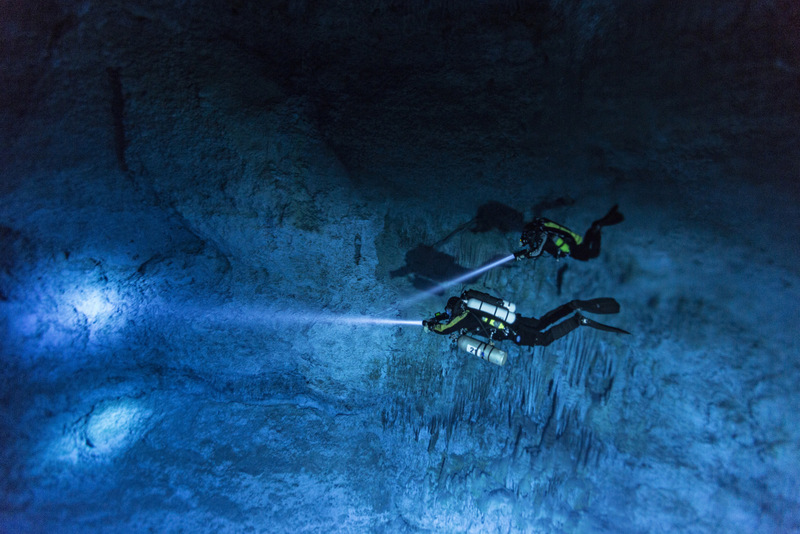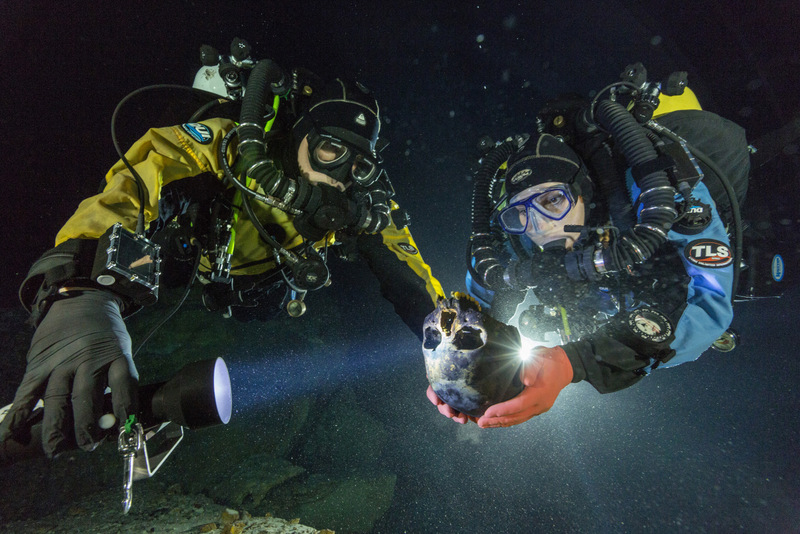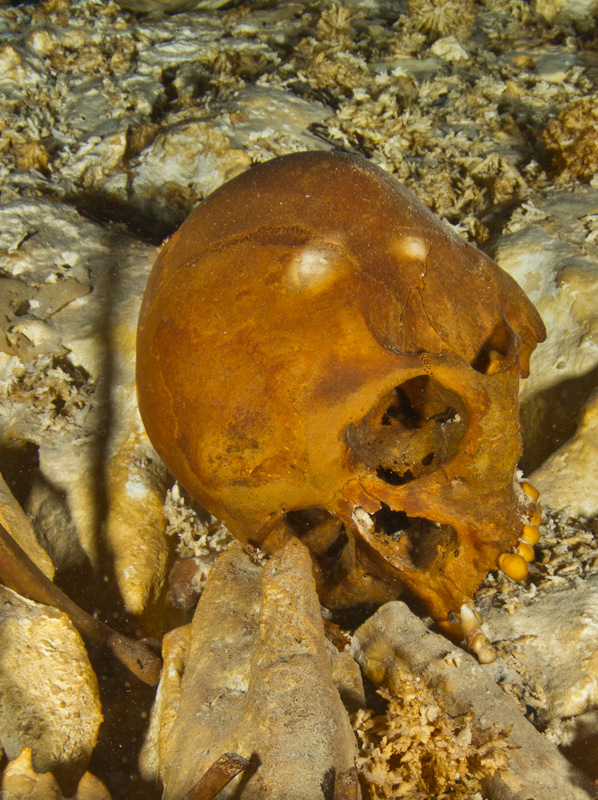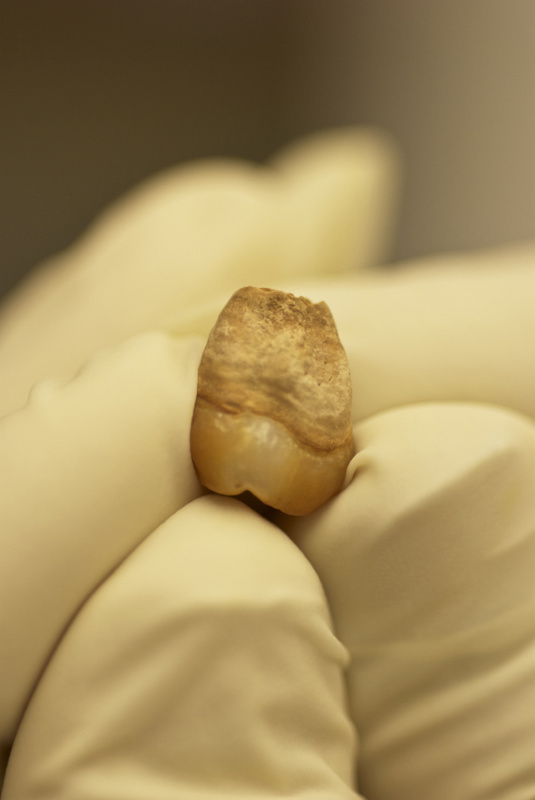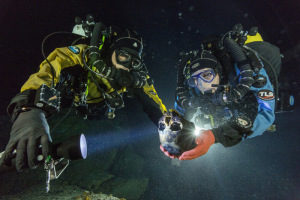 EMBARGOED: For release 2 p.m. (Eastern Time U.S.), Thursday, May 15, 2014PERMITTED USE: These images may be downloaded or are otherwise provided at no charge for one-time use for coverage or promotion of the National Geographic Society’s Hoyo Negro Skeleton announcement and exclusively in conjunction thereof. Copying, distribution, archiving, sublicensing, sale or resale of the images are prohibited. REQUIRED CREDIT AND CAPTION: Any and all image uses must (1) be properly credited to the relevant photographer, as shown in this metadata, and (2) be accompanied by a caption, which makes reference to the National Geographic Society’s Hoyo Negro Skeleton announcement. DEFAULT: Failure to comply with the prohibitions and requirements set forth above will obligate the individual or entity receiving this image to pay a fee determined by the National Geographic Society.Divers Alberto Nava and Susan Bird transport the Hoyo Negro skull to an underwater turntable so that it can be photographed in order to create a 3-D model.Researchers detailed their analysis of the oldest most complete, genetically intact human skeleton discovered in the New World in a paper published today in the journal Science. This project was led by the Mexican government’s National Institute of Anthropology and History and supported by the National Geographic Society.
EMBARGOED: For release 2 p.m. (Eastern Time U.S.), Thursday, May 15, 2014PERMITTED USE: These images may be downloaded or are otherwise provided at no charge for one-time use for coverage or promotion of the National Geographic Society’s Hoyo Negro Skeleton announcement and exclusively in conjunction thereof. Copying, distribution, archiving, sublicensing, sale or resale of the images are prohibited. REQUIRED CREDIT AND CAPTION: Any and all image uses must (1) be properly credited to the relevant photographer, as shown in this metadata, and (2) be accompanied by a caption, which makes reference to the National Geographic Society’s Hoyo Negro Skeleton announcement. DEFAULT: Failure to comply with the prohibitions and requirements set forth above will obligate the individual or entity receiving this image to pay a fee determined by the National Geographic Society.Divers Alberto Nava and Susan Bird transport the Hoyo Negro skull to an underwater turntable so that it can be photographed in order to create a 3-D model.Researchers detailed their analysis of the oldest most complete, genetically intact human skeleton discovered in the New World in a paper published today in the journal Science. This project was led by the Mexican government’s National Institute of Anthropology and History and supported by the National Geographic Society. Initially discovered in 2007 by a team of underwater archaeologists, her nearly complete skeleton was found within a submerged chamber (which site investigators called “Hoyo Negro”, or “black hole”) in the Sac Actun cave system on Mexico’s Eastern Yucatán Peninsula. Named “Naia” by the dive team, she was a slightly-built teenage girl at death, measuring only 4 feet 10 inches in height. Anthropologists who examined the skeleton determined that she was between 15 and 16 years old, and had likely fallen to her death into the chamber (a dry pit during the time of the fall) before the cave had subsequently filled with water due to climate change and rising sea levels.
The find was unprecedented for two reasons. The first reason had to do with the age. Scientists dated the skeleton to between 12,000 and 13,000 years ago based on radiocarbon dating of tooth enamel and Uranium/Thorium dating analyses of mineral deposits on her bones. Also, starting about 10,000 years ago, it is known that global glaciers melted, filling the caves with water as sea levels rose. The analysis indicated that the skeleton had to have been deposited before the cave system filled with water. Finally, in addition to the near-complete human skeleton, the researchers found the remains of 26 large mammals, including extinct taxa such as sabertooths and gomphotheres (extinct relatives of mastodons), another indicator of the age of the find. This made Naia one of the six oldest humans found in America.
The second reason was related to the pristine preservation of the bones. “The preservation of all the bones in this deep water-filled cave is amazing — the bones are beautifully laid out,” said Patricia A. Beddows of Northwestern University, a cave-diving member of the international team. “The girl’s skeleton is exceptionally complete because of the environment in which she died — she ended up in the right water and in a quiet place without any soil.” James Chatters of Applied Paleoscience, the lead author of the newly-published research report, elaborated further: “Paleoamerican skeletons are rare for several reasons. The people themselves were few; they were highly nomadic and seem to have buried or cremated the dead where they fell, making the locations of graves unpredictable; also, geologic processes have destroyed or deeply buried their graves.” Moreover, most unearthed ancient Native American skeletal remains are only found in a few fragments, and most of those have been estimated to be younger than 10,000 years old. The most widely accepted theory of Native American origins suggests that people reached the North American continent before that time.
_____________________________
Divers Susan Bird and Alberto Nava search the walls of Hoyo Negro, an underwater cave on Mexico’s Yucatán Peninsula where the remains of “Naia,” a 12,000- to 13,000-year-old teenage girl, were found. Image courtesy of Paul Nicklen/National Geographic
_______________________________
Divers Alberto Nava and Susan Bird transport the Hoyo Negro skull to an underwater turntable so that it can be photographed in order to create a 3-D model. Image courtesy of Paul Nicklen/National Geographic
______________________________
The skull of Naia on the floor of Hoyo Negro, as it appeared in December 2011, having rolled into a near-upright position. Photo by Roberto Chavez Arce
_____________________________
Deciphering the ancestry of the first people to populate the Americas has been a challenge. On the basis of genetics, modern Native Americans are thought to descend from Siberians who moved into eastern Beringia (the landmass connecting Asia and North America) between 26,000 and 18,000 years ago. These people, considered the earliest Americans, are suggested to have then spread southward and populated the rest of the continent. But despite widespread support for this idea, the ancestry of the earliest Americans is still debated because the facial features of the oldest American skeletons don’t look much like those of modern Native Americans. The famous Kennewick Man is a prime example.
“Modern Native Americans closely resemble people of China, Korea, and Japan,” Chatters said, “but the oldest American skeletons do not.” Scientists who have examined the fossils of the oldest skeletons have determined that their bodies were structured slightly differently than that of today’s Native American, such as longer, narrower crania and smaller, shorter faces. “This has led to speculation that perhaps the first Americans and Native Americans came from different homelands,” Chatters continued, “or migrated from Asia at different stages in their evolution.”
The biggest finding came, however, when the team analyzed the skeleton’s genetic makeup, with important implications about Native American origins.
“We tried a DNA extraction on the outside chance some fragments might remain,” Chatters said. “I was shocked when we actually got intact DNA.”
The study team analyzed the girl’s mitochondrial DNA (mtDNA), a useful tool for examining the relatedness of populations. Their analysis revealed a haplotype common to modern Native Americans, subhaplogroup D1. This genetic signature occurs only in the Americas. The report authors suggest that this genetic signature likely developed in Beringia after populations there split from other Asians, and indicates that individuals of this population traveled at least far and wide enough through the Americas to have reached Mexico by 12,000 – 13,000 BP. They further suggest that the differences in craniofacial form are probably best explained as evolutionary changes that happened after the divergence of Beringians from their Siberian ancestors. Thus the Americas, they theorize, were not colonized by separate migration events from different parts of Eurasia. Rather, the earliest Americans represent an early population expansion out of Beringia. This aligns with the hypothesis that both Paleoamericans and Native Americans derive from a single source population, hunter-gatherers who moved onto the Bering Land Bridge from northeast Asia (Beringia) between 26,000 and 18,000 years ago, spreading southward into North America sometime after 17,000 years ago.
Says Chatters: “This project is exciting on so many fronts: the beautiful cave, the incredibly well-preserved animal skeletons, the completeness of the human skeleton, the success of our innovative dating approach. But for me,” he said, “what is most exciting is that we finally have an answer, after 20 years, to a question that has plagued me since my first look at Kennewick Man: ‘Who were the first Americans?'”
_____________________________
The upper right third molar of Naia, which was used for both radiocarbon dating and DNA extraction. The tooth is held by ancient genetics expert Brian Kemp of Washington State University, who led the genetic research on the skeleton. Photo by James Chatters
________________________________
The complete report has been published in the May 15th online edition of the journal Science.
Participating and supporting institutions in the research included the National Geographic Society, the Archaeological Institute of America, the Waitt Institute, the Instituto Nacional de Antropología e Historia, NSF (Y.A., V.P., and D.K.), Pennsylvania State University, the University of New Mexico, the University of Texas at Austin, the University of Illinois, Urbana-Champaign, and DirectAMS.
Source: Adapted and edited from press releases of the American Association for the Advancement of Science, the National Geographic Society, and Northwestern University.
___________________________________________
Read about the most fascinating discoveries with a premium subscription to Popular Archaeology Magazine. Find out what Popular Archaeology Magazine is all about. AND MORE:
On the go? Purchase the mobile version of the current issue of Popular Archaeology Magazine here for only $2.99.
Popular Archaeology’s annual Discovery Edition eBook is a selection of the best stories published in Popular Archaeology Magazine in past issues, with an emphasis on some of the most significant, groundbreaking, or fascinating discoveries in the fields of archaeology and paleoanthropology and related fields. At least some of the articles have been updated or revised specifically for the Discovery edition. We can confidently say that there is no other single issue of an archaeology-related magazine, paper print or online, that contains as much major feature article content as this one. The latest issue, volume 2, has just been released. Go to the Discovery edition page for more information.

